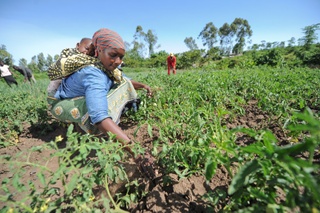News
Dialogues on How to Make Africa Grow - Agriculture
What are the five steps to success? Eliminate government price distortions in agriculture. Reduce fear of food shortages through better market forecasts. Government policies adopt modern agricultural practices, including mechanization, economies of scale and improved yields. Long-term security of title for farmers, whether leased or freehold. Improving logistics is fundamental to the success of food production and non-food agricultural exports.

And what are the challenges and opportunities? Agriculture is a story of immense unrealized African potential. Other regions have doubled or tripled agricultural production, while cereal production in Africa is 66% lower than the world average according to the FAO. Forty of African countries are food importers and 300 million farmers suffer from malnutrition.
The reasons for the stagnation of African agriculture are clear: instability, lack of clarity regarding land ownership, low investment in people and management systems, lack of economies of scale and technology and, in some cases, the effects of war. Note that 70% of the 600 million Africans engaged in agriculture are women and better performance can extend the benefits of economic growth to a marginalized sector of the population.
What are the key statistics?
Africa has 874 million hectares of arable agricultural land, 60% of the world's total. However, the continent uses only 43% of its arable land and less than 4% is irrigated. Fertilizer use is just 13% of the global average and the continent is relatively poorly mechanized, with less than 2 tractors per 1000 hectares, compared to the average in Asia or Latin America of 10 per 1000 hectares. Cereal imports to Africa total 100 million tons at an annual cost of 75 billion dollars in the note by the African Development Bank in January 2023.
What do we have as examples of success?
Since 1990, Argentina has made considerable investments in new agricultural techniques, notably injection sowing, along with the extensive use of herbicides and genetically modified seeds. China's demand for soybeans and the tripling of per capita meat consumption fueled the boom in Argentine exports.
According to agricultural experts, soy is meat. Soybean production increased from 1995 to 2010 to 93 million tons and exports increased, making Argentina the third largest soybean seed producing country, after the USA and Brazil.
The same happened in Brazil, which also increased its soybean exports to 54 million tons in 2014/15, with China absorbing almost 75% of all Brazilian production. Similar moments of rapid agrarian change occurred in India in the 1960s and 70s. The Bengal famine event was recorded as the world's worst food disaster and occurred in 1943, when four million people starved to death due to a failure to prioritize of food supply. This tragedy forced India to prioritize food security and agricultural production increased, through the expansion of agricultural areas, double cropping, improved technologies and better seeds. These changes increased cereal production from 72 million to over 130 million tons in 1978.
Vietnam is another example of success following a hunger crisis in the 1980s, in which the agrarian reform process was accelerated and the state monopoly was made more flexible. In 2008, Vietnam produced a surplus of 7 million tons, which allowed it to be the second largest rice exporter in the world, after Thailand.
Coffee is another example of success in Vietnam, an industry that currently employs 2.6 million people and whose beans are grown on half a million small farms. Vietnam's increased production resulted from Doi moi - or renewal, which aimed to create economic reforms through market liberalization and unlock the investment needed for rapid growth.
Africa also has success with Kenya and Ethiopia in floriculture, with Kenya's flower exports increasing 12-fold to 137,000 tonnes between 1988 and 2014, making it the third largest flower exporter in the world. Ethiopia is also a success with three Boeing 777s flying daily to Europe with cargo of flowers, with an average of 300 tons of flower exports per day for a year. Ethiopia offered low interest rates to attract investors and duty and tax exemptions for exporters. So what is the problem with African agriculture? Africa has had very poor agricultural performance, while the lower regions have turned over their income to feed their populations. Malnutrition remains high and affects at least a quarter of the population across the continent. This situation has a lasting effect on children and their cognitive development, setting the stage for generational problems and subsequent health problems.
The World Food Organization analyzed the reason for the systemic failure in food price costs, as in the US, the average American spends only 6.7% of their income on food and the first African country of the 92 surveyed by the Department of US agriculture is South Africa's with 19.4% of income on food, while Kenya and Nigeria spend 47% and 56.9% on food, respectively. This situation is not due to a scarcity of land or water, but rather to the lack of attractive and stable political regimes, with security of land tenure and a competitive approach.
How can we improve production, systems and technology?
At the end of the 19th century, nearly half of all U.S. workers worked in agriculture — 100 years later, it's less than 2%. This was the result of mechanization and technology. There is no reason why Africa cannot follow a similar path. The direction of profitable agriculture is toward larger, commercial, capital-intensive operations that provide economies of scale. Lampie Fick, former South African Minister of Agriculture, says that you cannot grow more crops on less land without changing practices. All of the world's major agricultural exporters use genetically modified organism crops.

South Africa, for example, doubled average incomes in just 10 years. The Western Cape is home to more than 50% of South Africa's wheat production, or 1.7 million tonnes of wheat. Here, productivity increased, not because of GME seeds, but due to the practice of conversational methods and the yield per hectare increased to 13 to 15 kilograms per millimeter of rainfall.
Emphasis is placed on understanding the soil component and the use of fertilizers and herbicides. But some farms with more than 5,000 hectares employ just nine people. There has been a revolution in the productivity of South African agriculture. But according to Heinrich Schonfeld - a farmer in the Cape Province, there is huge potential in the rest of Africa where we could harvest three harvests a year. Agriculture must be seen as an attractive investment possibility, a business and not just a passion. To achieve this, we must free ourselves from the subsistence farming mentality.
So what does Africa need to promote rapid agricultural progress?
African agriculture will require more than just capable farmers. It will require a series of integrated actions, such as the ecosystem of companies that produce seeds, fertilizers, equipment and logistics, together with an attractive government policy.
It is necessary to understand the limits of small farmers, as productivity will require correct machinery and processes. For example, a profitable farm requires at least 400 hectares in South Africa. But the future is not just about basic products and crops that cannot be fully mechanized, such as oranges or avocados, nuts and berries in South Africa, which can provide higher value jobs and employ many more people. Farmers need to feel safe enough not to put their life's investment at risk.
This article originally appeared on Expansão
Photo: Climate Change, Agriculture and Food Security Flickr


